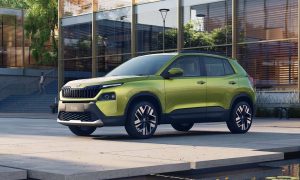Skoda has taken the wraps off the second-gen Kodiaq SUV—which boasts a fresh design, more space, new features and new technologies. Pricing and availability information are not available just yet, but your local dealer might offer some reliable information. In the meantime, let’s try and figure out what’s all the hoopla.
At launch, the new Kodiaq will be available in regular, Sportline and iV (PHEV) variants, with each having some distinguishing styling elements. The Kodiaq Sportline, for example, will have dark elements such as the grille, bumper inserts, ORVMs, roof rails, and badges. The grille can be optionally illuminated with 14 vertical light strips. Also making its debut with the new Kodiaq are the TOP LED Matrix headlights—which are claimed to contain 50% more light segments and offer 15% more light output than those of the first generation. These headlights are standard on the Sportline.
At the rear, there are these so-called TOP LED taillights with dynamic turn signals and crystalline elements—similar to those in the headlights. These taillights are standard in the Sportline trim. The base models ride on 17-inch wheels, but the examples shown here sport 20-inch wheels with aero fins. For those interested in knowing the dimensions, the new Kodiaq measures 4,758 mm long, 1,864 mm wide and 1,659 mm tall, with a wheelbase of 2,791 mm. While there’s an additional length of over 60 mm, the wheelbase remains identical to the outgoing model.
The new Kodiaq will be available in 5- or 7-seater configuration. Skoda claims that in the 7-seater version, passengers in the 3rd-row seats now have 920 mm of headroom, 15 mm more than in the predecessor. Luggage capacity has also increased: in the 5-seater version, it has grown by 75 litres to 910 litres without folding the rear seats down. With the rear seats folded down, the maximum capacity has increased by 40 litres to 2,105 litres. The 7-seater now holds 340 litres behind the 3rd-row seats, 70 more than before, and 845 litres with the 3rd-row folded down. This is an increase of 80 litres. The 7-seater’s maximum cargo capacity is now 2,035 litres, 30 litres more than in the first generation.
As for exterior paint colors, the new Kodiaq offers 9 options, including 2 solid and 7 metallic, of which, there’s the new Bronx Gold Metallic.
Inside, the dashboard design looks rather busy, but apparently, the designers were going for an X-shaped element; even the stitching on the dashboard has X-shapes. But anyway, a 10-inch touchscreen comes standard, but the one you’re seeing here is an optional 13-inch touchscreen. Other key highlights include a 10-inch Virtual Cockpit (digital cluster), a head-up display, multi-functional rotary dials with built-in displays, four USB-C ports, a 15-watt USB-C port on the back of the interior mirror, optional 14-speaker Canton audio system, and optional Ergo seats with pneumatic massage function.
Each of these seats has 10 air cushions that can be programmed via the infotainment menu or controls on the seat, with a choice of intensity levels and time settings. Also, notice that the PRND selector is a stalk mounted on the steering column.
As for sustainability stuff, Skoda claims that the textiles used for the seat upholstery, the carpets in the cabin and the luggage compartment, as well as the headliner, are made of 100% recycled polyester or, in the case of the ‘Lounge’ interior theme, a combination of recycled yarns with 40% natural wool. The leather featured in the ‘ecoSuite’ theme is tanned in an environmentally friendly way using residues from coffee bean processing.
As for safety systems, the new Kodiaq comes with up to 9 airbags as standard. ADAS include all the usual stuff such as Collision Avoidance Assist, Crossroad Assist, Exit Warning, Automated Emergency Braking, Intelligent Park Assist, Side Assist and Travel Assist. Options include Trained Parking (memorised parking manoeuvres), Remote Parking, and Assisted Drive package that adds Adaptive Lane Assist and Adaptive Cruise Control to Travel Assist.
Moving on to the juicy bits of the story, the new Kodiaq will be available with two petrol engines and two diesel engines, all paired with a 7-speed DSG.
The petrol option starts with a 1.5L TSI with 110 kW (150 metric hp) and 250 Nm (184 lb-ft); this engine is supported by a 48-volt mild-hybrid system. A 2.0L TSI option is also available with 150 kW (204 metric hp) and 320 Nm (236 lb-ft); AWD is standard here.
For those who want a diesel, a 2.0L TDI is available in two options: 110 kW (150 metric hp) and 360 Nm (265.5 lb-ft), and 142 kW (193 metric hp) and 400 Nm (295 lb-ft) + AWD.
For those who like to plug-in, the new Kodiaq offers the Kodiaq iV, combining a 2.0L TSI with an electric motor integrated into a 6-speed DSG, offering combined figures of 150 kW (204 metric hp) and 350 Nm (258 lb-ft). A 25.7 kWh battery pack is estimated to offer a pure electric range of over 100 km (62+ mi). The car can accept up to 11 kW AC charging and up to 50 kW DC charging. Due to the battery pack, the luggage capacity behind the rear seats here is 745 litres.

Leave a Reply
Note: Comments that are unrelated to the post above get automatically filtered into the trash bin.


























































